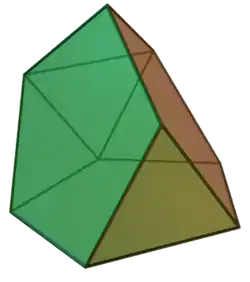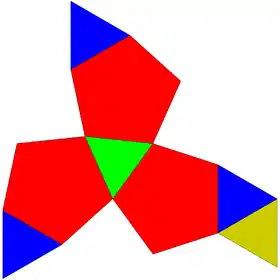Tridiminished icosahedron
In geometry, the tridiminished icosahedron is one of the Johnson solids (J63). The name refers to one way of constructing it, by removing three pentagonal pyramids (J2) from a regular icosahedron, which replaces three sets of five triangular faces from the icosahedron with three mutually adjacent pentagonal faces.
| Tridiminished icosahedron | |
|---|---|
 | |
| Type | Johnson J62 – J63 – J64 |
| Faces | 2+3 triangles 3 pentagons |
| Edges | 15 |
| Vertices | 9 |
| Vertex configuration | 2x3(3.52) 3(33.5) |
| Symmetry group | C3v |
| Dual polyhedron | Dual of tridiminished icosahedron (unnamed enneahedron) |
| Properties | convex |
| Net | |
 | |
A Johnson solid is one of 92 strictly convex polyhedra that is composed of regular polygon faces but are not uniform polyhedra (that is, they are not Platonic solids, Archimedean solids, prisms, or antiprisms). They were named by Norman Johnson, who first listed these polyhedra in 1966.[1]
Related polytopes
The tridiminished icosahedron is the vertex figure of the snub 24-cell, a uniform 4-polytope (4-dimensional polytope).
See also
- Diminished icosahedron (J11)
- Metabidiminished icosahedron (J62)
External links
- Johnson, Norman W. (1966), "Convex polyhedra with regular faces", Canadian Journal of Mathematics, 18: 169–200, doi:10.4153/cjm-1966-021-8, MR 0185507, Zbl 0132.14603.
This article is issued from Wikipedia. The text is licensed under Creative Commons - Attribution - Sharealike. Additional terms may apply for the media files.